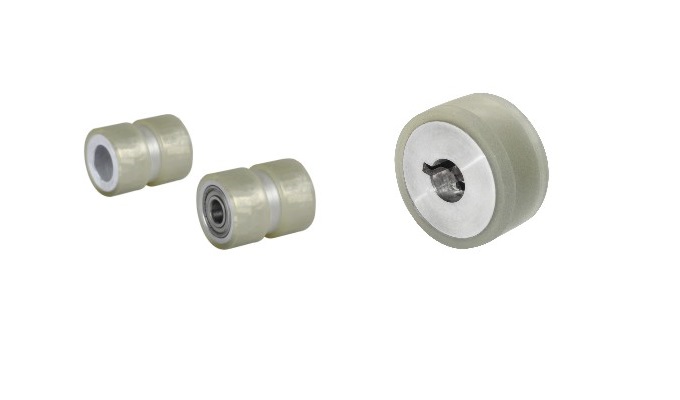Introduction to Coated Rollers
The rubber-coated roller is a transmission component in which elastomers such as polyurethane, silicone, and nitrile rubber are sintered and coated on the surface of the core material after a special sandblasting process. It can play a role in protection, shock absorption, and buffering. The coating thickness and hardness are optional, and you can also choose special product surface requirements, such as roller surface knurling, tapered rollers, or arc rollers, anti-static rollers, etc.
Commonly Used Materials for Coated Rollers
1.Polyurethane
It has good wear resistance. The higher the hardness, the greater the wear resistance coefficient. It is also oil-resistant, low-temperature resistant, aging-resistant, has high hardness, and is elastic. It is widely used to prevent scratches caused by tight transportation of fragile objects such as glass and acrylic. and cracks. Polyurethane has low dust resistance, and because it does not contain carbon, it is a material that is not prone to color transfer.
2. Silicone Rubber
It is a material with high heat resistance, good insulation performance and aging resistance. It is a highly safe product that can be used in medical, food, electronic equipment and other applications that require heat resistance. Rubber prevents scratches and cracks on the workpiece during fastening, it has a good effect in buffering and damping impact parts and preventing vibration.
3.Nitrile rubber
It is suitable for use in oil-resistant occasions, is relatively cheap, and is an economical product.
Performance of Encapsulated Materials
1. Hardness of the rubber coating material
At present, the hardness of the encapsulation material polyurethane, silicone rubber, and nitrile rubber ranges from A30 to A95.
| Hardness | Equivalent to |
|---|---|
| A95 | Golf ball |
| A90 | Baseball |
| A70 | Softball |
| A50 | Eraser |
| A30 | Bicycle inner tube |
2. Characteristics of rubber coating materials

3. Chemical resistance of the encapsulated materials

Selection of Coated rollers
When selecting a rubber-coated roller, select the required diameter D, length L, rubber material and thickness T, rubber hardness A, and installation method. Customization based on drawings is also supported.
Product Application Cases
Listed several typical application scenarios to share with you.
1. Roller with keyway and set screw
Model (recommended) QAK
Application:
Suitable for transporting and sliding various workpieces. It can be applied on a belt or used with a pair of rollers for transmission.

Roller with keyway and set screw
Model (recommended) QAJ series
Application: Suitable for transporting and sliding various workpieces. It can be applied on a belt or used with a pair of rollers for transmission.

2. Vertical guide wheel
Model (recommended) QBQ series, customizable rubber coating
Application scenario: Installed on the side panel of the assembly line to prevent goods from touching the side panel and preventing forward movement.
To prevent the goods from falling. It is mostly used on logistics conveying lines and out of curves, and can also be used in conjunction with belt strips.
Watch more, This is Yihwda's rubber-covered rollers workshop, Here we show you how to go from liquid polyethylene raw material to rubber-covered rollers step by step.
For more product knowledge, please visit Yiheda News. If you are interested in our products, click here → Contact Us.






